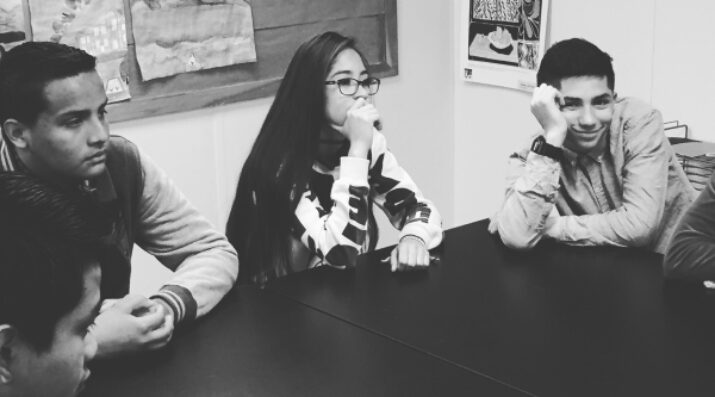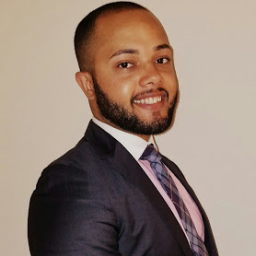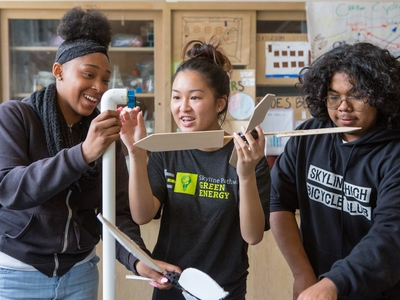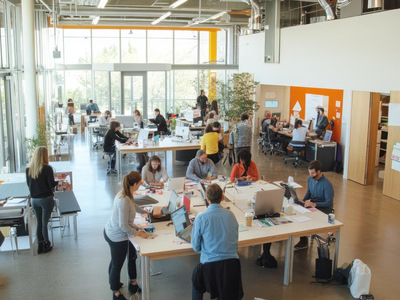New Designs for School
Supporting Emergent Multilingual Learners with Next Gen Learning
Topics

We’ve all had the experience of truly purposeful, authentic learning and know how valuable it is. Educators are taking the best of what we know about learning, student support, effective instruction, and interpersonal skill-building to completely reimagine schools so that students experience that kind of purposeful learning all day, every day.
Next gen learning is uniquely positioned to support emergent multilingual learners by integrating language and content in engaging, high-quality learning experiences.
I remember sitting at my desk at the Rockwell Group architectural firm at just 16 years old, applying everything I had learned in AutoCAD to a small project for the Rosa Mexicano restaurant in Washington, D.C. That opportunity challenged me, stretched my thinking about what kind of future I might want, and introduced me to people I otherwise would not have met. As an emergent multilingual learner, this experience pushed me far beyond my comfort zone and gave me the chance to acquire and develop new language skills in an authentic, real-world setting—far removed from the familiarity of my everyday environment.
Why Next Gen Learning Matters for Multilingual Learners
Yet, when people talk about innovation or next generation learning, they often don’t associate it with spaces that serve emergent multilingual learners. These students are not typically seen as being at the forefront of innovative educational practice. But in truth, next gen learning environments—those that are student-centered, personalized, and competency-based—are uniquely positioned to support multilingual learners. These approaches allow for the kind of personalization that supports simultaneous language and content acquisition while engaging students in rigorous, high-quality learning experiences that extend beyond academic content. Like my experience at Rockwell, next gen learning brings learning to life in ways that deepen engagement, maintain academic rigor, empower students to take ownership of their learning, and lead to academic success.
While there is deep potential for next gen learning in spaces that serve emergent multilingual learners, these are practices that are often overlooked for this population of students. There are a number of root causes, but a key issue is that educators are already overwhelmed at the daunting task of supporting both content and language acquisition for their multilingual learners. For example, while 67 percent of all teachers have at least one English learner in their class, only 10 percent (8 percent of high school teachers) have a major, minor, or certification in teaching English as a Second Language (ESL) (NCES, 2025). With many competing priorities, schools and districts may not have the capacity to tend to the needs of their educators in supporting multilingual learners in ways that are most meaningful and effective.
At NGLC we define next gen learning as learning approaches that develop students in well-rounded ways that speak to the strengths, needs, and cultural backgrounds of each individual student as well as enable students to successfully acquire skills and knowledge that goes beyond content. There are a variety of approaches to support this type of learning: project-based learning, competency-based learning, placed-based learning, etc. These are just three examples of next gen learning strategies that can support the deeper learning for multilingual learners to be successful in their post-secondary choices.
Key Principles for Supporting Multilingual Learners
As schools and districts begin to think about how to integrate meaningful next gen learning in their communities, they should consider four key principles: high quality instructional materials with appropriate supports, strategies to develop a deep understanding of their multilingual learner community, effective staff development, and seeing caregivers and multilingual learners themselves as change agents.
1. Increased Support Does Not Mean Lessened Rigor
I firmly believe that if you set a high bar for students—especially emergent multilingual learners—they will rise to meet the challenge. Rather than diluting learning experiences to meet students’ needs, educators should focus on providing strategic supports, such as thoughtful scaffolding and differentiated materials, so that every learner can engage deeply with rigorous content. Caution: When it comes to supporting multilingual learners in the classroom, not everything within a lesson needs to be scaffolded or differentiated.
Begin by reviewing the standards and skills you want your students to master. Next, decide which aspect of the lesson requires the greatest support:
- Process: Do students need a step-by-step breakdown or guided practice before working independently?
- Content: Would chunking the material into manageable segments help students better understand complex topics?
- Product: Could offering multiple ways to demonstrate learning (e.g., projects, presentations, or essays) ensure that all students can succeed?
Integrate these questions into each lesson, unit, and classroom practice. School and district leaders can play an essential role here by identifying which common strategies work best for their specific community of learners and connecting those strategies to a shared vision of teaching and learning. At International High School at Langley Park (IHSLP) in Bladensburg, Maryland, we developed common systems and structures for teaching and learning that spanned across the content areas. We even brought in subject areas that do not always engage in the teaching and learning conversations often reserved for core content areas.
One of the components that distinguished our unit development was a direct planning of integrated language functions and identification of Bloom’s cognitive level built into each module. It put essential elements of language learning and level of rigor directly into a teacher’s metacognitive thinking around what, how, and why students were learning something. The assistant principal at the time, Daniel Sass, and I took time to review each of the unit plans and give feedback to each teacher. Because we spent time giving that feedback, we were able to 1) know what would be happening throughout a school year, but also 2) give feedback in areas where we thought students could be challenged differently. The English team built a system around student language levels where students at different language entry points would experience a lesser or more heavily scaffolded experience connected to that data point. And yet, students had choice and could challenge themselves beyond what the WIDA ACCESS test said about where they were in English language proficiency.
When districts develop or purchase curricula, rather than teachers creating their own, it’s critical that these materials embed scaffolding options. This is particularly transformative in urban education settings where newer teachers may have less experience tailoring instruction for diverse language needs. One starting point could be exploring Springpoint’s definition of rigor and purpose, which draws on decades of research on adolescent development. Another is the NGLC Transformation Design Framework, which emphasizes human-centered practices and continuous school improvement for next gen learning. You can read about additional learning strategies used at IHSLP through an interview with a former student, Jimmi Rios.
Change doesn’t happen overnight, but begins with small steps toward a big, audacious goal: providing optimal instruction for every student. By aligning clear expectations with meaningful support, you help ensure that emergent multilingual learners—and indeed all learners—experience the high-level, engaging education they deserve.
2. Know Your Students Deep and Well
Emergent multilingual learners come from a wide variety of backgrounds, shaped by socio-economic factors and differing prior educational experiences. While many of these students are born in the United States and begin schooling here at the elementary level (Pew Research, 2018), others migrate from countries where the quality and nature of education vary greatly. Some may even be fluent in more than one language (that’s why I refer to supporting emergent multilingual students rather than emergent bilingual students).
To effectively serve these learners, schools must have systems in place to assess each student’s academic language levels—both in their native language(s) and in English—as well as their overall schooling background. Educators also benefit from knowing the broader family or caregiver dynamics, since students may live with extended family members or share housing arrangements that are unfamiliar to traditional school models. These factors directly influence how teachers and administrators develop supports and interventions. Here are some of IHSLP’s target intake questions:
- Describe an average day of school. (gave us insight into how students were learning in school)
- Have you ever stopped attending school at any point for more than a month? (helped us identify students with interrupted formal education)
- Were you absent a lot? How often were you absent (e.g. weekly or monthly)?
- Can your family read and write in their first language? (gave insight on literacy of caregivers)
Rather than individually probing every student, schools can streamline data collection through a two-stage intake approach, such as the one at IHSLP. First, when students arrive at the district’s international office, basic information is gathered and an abridged language exam is administered. Next, at the school level, students participate in a more detailed intake interview with a team of teachers and other stakeholders. Here, data is collected on numeracy, literacy, family history, and prior educational experiences. It is the same process whether a student is new to the country or has attended a middle school in the United States.
This data is then used to organize students into advisory groups and classroom cohorts, thereby supporting educators in responding more effectively to each learner’s unique needs. This process also flags additional resources a student or family might require—whether that involves language support, access to technology, or social services. Ultimately, a well-structured intake system ensures that schools can provide relevant, targeted support for emergent multilingual learners, leading to more equitable and meaningful learning experiences for all.
3. Educators Need to Develop the Skills Necessary to Serve Emergent MLLs
I will always highlight the hiring process at IHSLP, riddled with activities I had picked up over time and across different experiences. It reflected an expectation of how we wanted learning to look in our school and how we wanted adults to work with one another. In fact, for the first four years of its existence, IHSLP teacher applicants experienced group interviews, which is uncommon in teacher hiring experiences. The type of collaboration we envisioned for teaching and learning was an essential practice and we therefore needed to assess how different groups and configurations of teachers across different content areas would work together. These collaborative practices were further cemented in collaborative planning, instructional leadership team meetings, classroom practice, adult and student restorative circles, and kid talk meetings, to name a few.
Ongoing, high-quality professional development is essential to equip educators with the skills, strategies, and confidence to effectively teach emergent multilingual learners. While next gen learning methods can bring fresh approaches, solid instructional practice remains the foundation. Given the high number of teachers leaving the profession (NCES, 2023), it’s more important than ever to ensure new and existing educators have a strong “recipe” for success—one they can refine over time. For adults teaching emergent multilingual learners in their buildings, they must be equipped to tackle language and content strategies most appropriate for their students and understand when to use different types of scaffolds and differentiated activities.
As educators explore next gen practices, professional development sessions should explicitly address how these instructional strategies apply to different subgroups. This clarity will help teachers understand the nuances of teaching multilingual learners. Additionally, effective training is purposeful, interconnected (not a series of one-off workshops), and aligned with a district or school’s overall vision for teaching and learning. In visiting schools across the country—from California to Maine—I’ve seen that professional development often lacks cohesion or fails to meet the needs of educators striving to improve instruction for their students. Read more about strategies for educator collaboration in support of emergent multilingual learners.
By creating a deliberate, sustained approach for professional learning, schools and districts can ensure that teachers build the necessary skills and instructional practices to support every learner, including those acquiring English language skills, in a more consistent and meaningful way.
4. Emergent Multilingual Learners and their Family Members Can Be Change Agents Too!
Multilingual learners and their families possess valuable insights that can enrich your school community, even if language barriers sometimes create misunderstandings. By acknowledging and integrating their perspectives, educators may discover new cultural or educational practices—ones that can enhance teaching and learning for everyone. Some key questions for inclusive engagement:
- Collaborative Vision: How are you shaping a shared definition of success that actively involves students, families, and other stakeholders?
- Building Trust: In what ways have you established rapport within the community to ensure people feel empowered to speak up? How might you gain a deeper understanding of your emergent multilingual learners and their families through an understanding of the communities they come from?
- District Policies: Which policies support or hinder family and student input in the changes your school or district is attempting to implement?
- Ongoing Evaluation: How regularly do you revisit these policies and practices to confirm they remain effective?
At IHSLP, an entire body of students who identified themselves as emergent multilingual learners led the student government association. I remember having monthly meetings with students (and more, when needed) connected to what their vision was to make IHSLP a better learning space. Students were also involved in decision-making when we were in line to get a new school building and participated in design sessions with architects. They were also part of the community school coordination meetings where decisions were made about how to spend those funds. One of the most formative experiences for students who participated was their contribution to the evolution of the language competencies that had been created years prior to their first review. Our ESOL teachers led the effort and created an entire process that was guided by student voice. Those language rubrics became stronger because students had a say in what was working or not with those competencies and how they were written. You can read more about that in “A Full Spectrum Narrative of a School for English Language Learners.”
In order to get to this place where families see themselves as change agents takes a lot of work. There are a variety of considerations that come into play when thinking about the families you serve, the cultural practices they observe, and their direct experience with schooling. In Latino culture, for example, we send students off to school and we place a high value on schools and educators taking care of our children while we go to work. We place a high value of trust and send our students with the belief that they are getting everything they need through the eight hour school day. In engaging students and families as change agents, it is the school’s role to help families see themselves differently and provide some of the necessary resources to ensure a caregiver can be actively engaged in decision-making opportunities. This could be in the form of translation services at meetings, providing caregiving services, and offering a variety of opportunities for decision-making activities to take place, just to name a few.
Creating coherent systems for teaching and learning requires bringing diverse voices to the table. At NGLC, we believe the greatest impact occurs when we engage those closest to the work, especially those who may have been historically overlooked. Designing optimal learning environments with this group of students and their families ultimately benefits the entire school community.
Empower Multilingual Learners with Next Gen Learning
Emergent multilingual learners deserve educational environments that offer high-quality instruction, maintain rigorous academic expectations, and provide the necessary supports for their success. At NGLC, we believe this is possible through the implementation of next generation learning practices that foster 21st-century skills and create ongoing opportunities for meaningful language use. Educators, as well as school and district leaders, should consider incorporating these strategies to ensure emergent multilingual learners are prepared for the future they deserve—supported by coherent systems that educators, administrators, caregivers, and students can trust and use effectively. Can you imagine a world where ALL students have a Rockwell group kind of experience, where they get to put the skills they are learning to practice in an immediate and authentic way?
Explore NGLC’s programs and resources to advance multilingual education—and join us in this important work! Join us!
Photo at top of International High School at Langley Park students, courtesy of the author.




